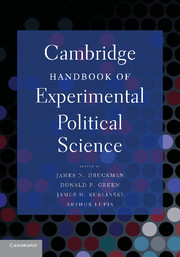Book contents
- Frontmatter
- Contents
- List of Tables
- List of Figures
- Contributors
- Acknowledgments
- INTRODUCTION
- PART I DESIGNING EXPERIMENTS
- PART II THE DEVELOPMENT OF EXPERIMENTS IN POLITICAL SCIENCE
- PART III DECISION MAKING
- PART IV VOTE CHOICE, CANDIDATE EVALUATIONS, AND TURNOUT
- 13 Candidate Impressions and Evaluations
- 14 Media and Politics
- 15 Candidate Advertisements
- 16 Voter Mobilization
- PART V INTERPERSONAL RELATIONS
- PART VI IDENTITY, ETHNICITY, AND POLITICS
- PART VII INSTITUTIONS AND BEHAVIOR
- PART VIII ELITE BARGAINING
- PART IX ADVANCED EXPERIMENTAL METHODS
- AFTERWORD
- Name Index
- Subject Index
- References
14 - Media and Politics
Published online by Cambridge University Press: 05 June 2012
- Frontmatter
- Contents
- List of Tables
- List of Figures
- Contributors
- Acknowledgments
- INTRODUCTION
- PART I DESIGNING EXPERIMENTS
- PART II THE DEVELOPMENT OF EXPERIMENTS IN POLITICAL SCIENCE
- PART III DECISION MAKING
- PART IV VOTE CHOICE, CANDIDATE EVALUATIONS, AND TURNOUT
- 13 Candidate Impressions and Evaluations
- 14 Media and Politics
- 15 Candidate Advertisements
- 16 Voter Mobilization
- PART V INTERPERSONAL RELATIONS
- PART VI IDENTITY, ETHNICITY, AND POLITICS
- PART VII INSTITUTIONS AND BEHAVIOR
- PART VIII ELITE BARGAINING
- PART IX ADVANCED EXPERIMENTAL METHODS
- AFTERWORD
- Name Index
- Subject Index
- References
Summary
Nobody needs another summary of mass media research right now; there are plenty of fine, current surveys of the field (Kinder 2003). Our chapter discusses specifically how experimental research provides insight into the relationship between the media and the political world. We are especially interested in important questions that experimentation is well suited to address. Experimentation has been vital to the development of scholarship in this area, but we should also recognize when it is best to step away and choose another method.
Causation and experimentation go together hand in glove, and questions of causation are paramount in both lay and scholarly thought about the media (Iyengar 1990). Questions about the social, economic, and organizational factors that determine mass media content are certainly fascinating and relevant in their own right. One can argue, however, that such questions eventually beget questions about the ultimate impact of that content on individuals and political processes and institutions.
As an example of the promise and limitation of experimentation in mass media research, consider the media's constant bugbear: public perceptions of ideological bias in the news. The usual form of this complaint is that media organizations subtly stump for liberal causes (Goldberg 2001). Although this complaint often amounts to little more than strategic bluster, it is conceivable that the increasing differentiation of the media marketplace will encourage news organizations to become more forthright in displaying overt liberal or conservative commentary (Dalton, Beck, and Huckfeldt 1998).
- Type
- Chapter
- Information
- Cambridge Handbook of Experimental Political Science , pp. 201 - 213Publisher: Cambridge University PressPrint publication year: 2011
References
- 5
- Cited by



